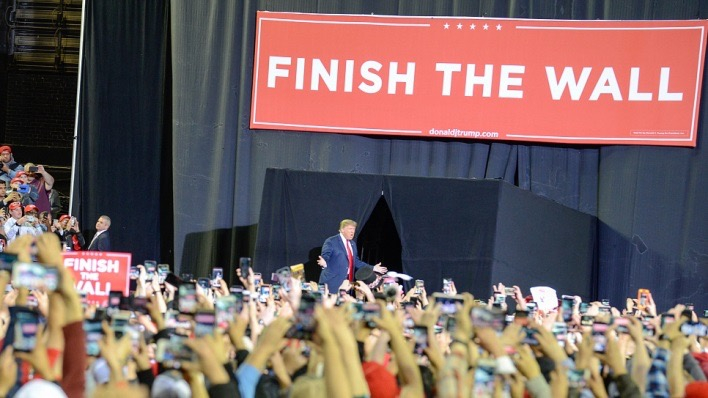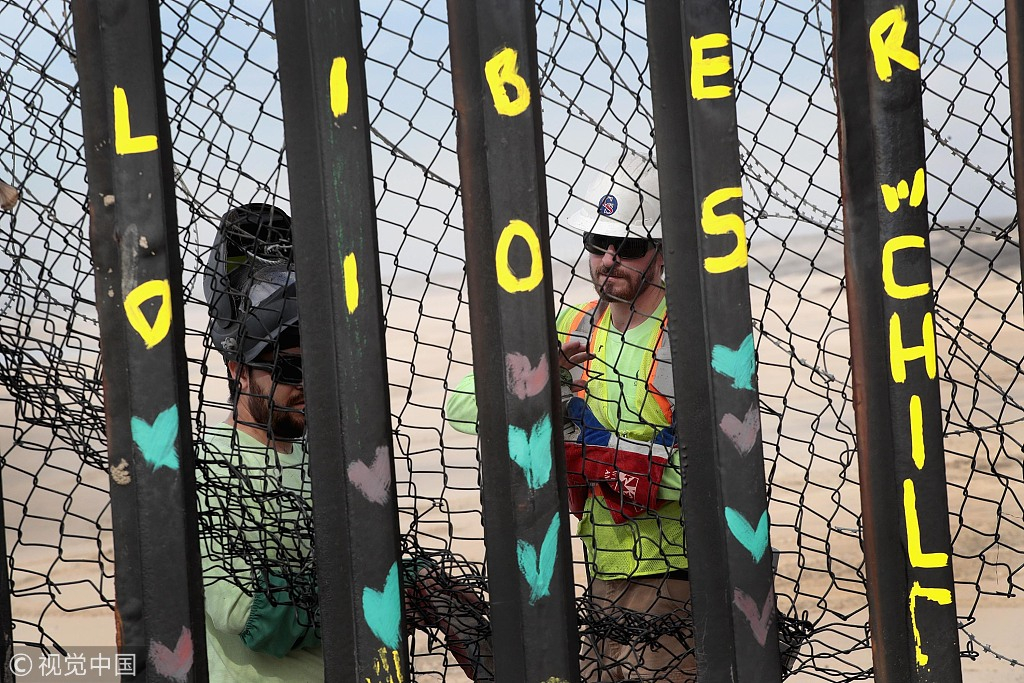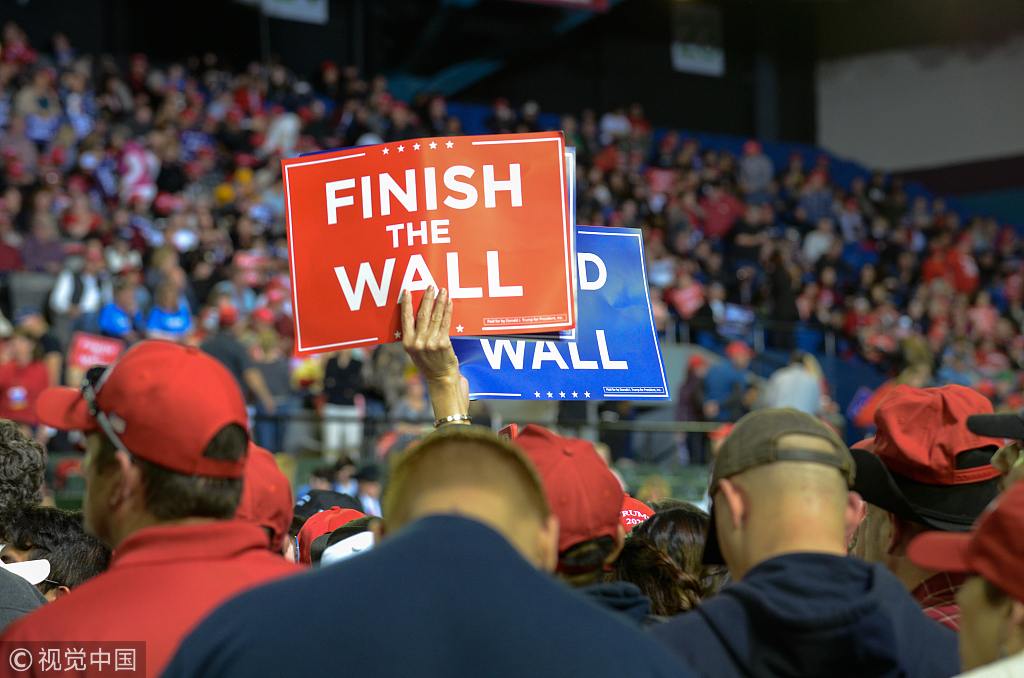
World
17:01, 13-Feb-2019
Behind Trump's Wall: From memory trick to totemic policy
Updated
15:02, 14-Feb-2019
By John Goodrich

As the clock ticks towards Friday's deadline to avert another government shutdown in the United States, the "wall" is once again at the top of the country's political agenda.
The proposed border wall between the U.S. and Mexico is now synonymous with the Trump presidency, a symbol of strength and nationalism for his supporters and an emblem of racism and division to his opponents.
A deal thrashed out by lawmakers this week is understood to allocate around 1.4 billion U.S. dollars in funding for 88 kilometers of new fencing, but still needs to be passed by Congress and signed off by the president.

U.S. President Donald Trump speaks during a rally in El Paso, Texas, on February 11, 2019. /VCG Photo
U.S. President Donald Trump speaks during a rally in El Paso, Texas, on February 11, 2019. /VCG Photo
The Trump wall dates back four-and-a-half years and is a tale that began as a simple memory trick but developed into a core campaign and governing symbol.
Foundations
As strategists looked ahead to how Trump would perform on the campaign trail, they had a concern. Whereas more traditional candidates had a tight, scripted message, Trump's rhetorical freestyle risked skipping over key campaign arguments.
Back in 2014, advisers hit upon a tactic to help him remember to address immigration in speeches by linking it to one of his main interests: building.
"How do we get him to continue to talk about immigration?” Sam Nunberg asked Roger Stone, both early advisers to Trump, according to the New York Times. “We're going to get him to talk about he's going to build a wall.”

Screenshot from Trump's twitter handle
Screenshot from Trump's twitter handle
On August 6, 2014, Trump tweeted "SECURE THE BORDER! BUILD A WALL!" – more than 10 months before he officially launched his campaign.
At that point 1,051 kilometers of border fence was already in place according to AP, built under the Secure Fence Act passed in 2006, but “Build the Wall” became the slogan on which his campaign was built.
Campaign chants
Trump officially launched his bid for the presidency on June 16, 2015, with a speech including the words, ”I would build a great wall, and nobody builds walls better than me, believe me, and I'll build them very inexpensively, I will build a great, great wall on our southern border. And I will have Mexico pay for that wall.”
His unique style soon made him a superstar candidate drawing huge crowds and media attention - and the wall took on a life of its own.
The candidate tweeted about it with increasing regularity and began holding rallies in border states much like the event held on Monday in El Paso.

Screenshot from Trump's twitter handle
Screenshot from Trump's twitter handle
"Build the Wall" soon became a familiar chant, alongside "Lock Her Up" – a cry referring to Hillary Clinton that was still shouted at the El Paso rally this week.
The wall chimed with Trump's supporters and came to embody his message: A promise to build barriers to protect Americans.

Screenshot from Trump's twitter handle
Screenshot from Trump's twitter handle
Back then, the wall was going to be 1,600 kilometers long, built of solid concrete and paid for by Mexico. In fact, according to factba.se, from Trump's announcement speech to the election, he declared 212 times that Mexico would pay for the wall.
Now he insists Mexico will pay through gains made by the renegotiated trade deal with the U.S. and Canada, an agreement which is yet to be ratified. Meanwhile, the wall has evolved from concrete to solar to see-through to steel slats.
Lost opportunities
On entering the White House, immigration was at the forefront of the Trump agenda – within a week he had signed executive orders calling for the secretary of homeland security to prepare budget requests for the wall and ordered the infamous travel ban.
But over the next two years, despite the Republicans controlling both houses of Congress, Trump rejected several offers that would have funded a border wall.
In January 2018 at the “Cheeseburger summit,” Senate minority leader Chuck Schumer reportedly offered Trump 25 billion U.S. dollars for the wall in exchange for protection for Dreamers, people brought to the U.S. illegally as children. It was rejected, amid fears of a backlash from the right.

Workers on the American side of the border repair a hole in the border wall, on January 28, 2019, in Tijuana, Mexico. /VCG Photo
Workers on the American side of the border repair a hole in the border wall, on January 28, 2019, in Tijuana, Mexico. /VCG Photo
The next month, a similar compromise was put forward in a bipartisan move in Congress. Trump dismissed it as a “giant amnesty.” It still won 54 votes in the Senate, but below the 60-vote threshold.
In March, the Democrats made a similar offer: 25 billion U.S. dollars for the wall in exchange for protection for Dreamers. A counter offer of time-limited protection for the Dreamers was rejected by Democrats.
Ultimately, 1.4 billion U.S dollars was allocated to border fencing in March, including 53 kilometers of new fencing, though work wasn't due to begin until February 2018 and it was to be based on existing designs rather than prototypes commissioned by the president.
Trump then made immigration the Republican campaign theme of the midterms, and after a comprehensive defeat in November's elections, faced divided government and an insistence from new House Speaker Nancy Pelosi that “we are not doing a wall.”
A 35-day government shutdown followed, with Trump demanding 5.7 billion U.S. dollars for a wall. The latest deal offers 1.4 billion U.S. dollars for border barriers.
Campaign 2020
The campaign for the White House is now well underway, and in February's State of the Union address and the rally in El Paso, Trump set out the themes of his reelection campaign in a long speech peppered with criticisms of Democrats.

A supporter of President Donald Trump's proposed border wall holds a sign at a rally for the president at the El Paso County Coliseum in El Paso, Texas, on February 11, 2019. /VCG Photo
A supporter of President Donald Trump's proposed border wall holds a sign at a rally for the president at the El Paso County Coliseum in El Paso, Texas, on February 11, 2019. /VCG Photo
"Build the Wall" signs have been replaced with "Finish the Wall," and the president has suggested "Make America Great Again" would become "Keep America Great."
The Democrats are equally dug in, with Pelosi denouncing a wall as “immoral” and Schumer describing it as “medieval.” Strategically-placed fencing or barriers, however, are acceptable to many Democrats. The fight over the next 20 months is likely to be as much about messaging as money or construction.
Whatever happens this week – if the government is shut down again, if the president signs the compromise or if he calls a national emergency – Trump and Democrats are positioning to call a win. For both sides, the wall symbolizes much more than a physical structure.

SITEMAP
Copyright © 2018 CGTN. Beijing ICP prepared NO.16065310-3
Copyright © 2018 CGTN. Beijing ICP prepared NO.16065310-3